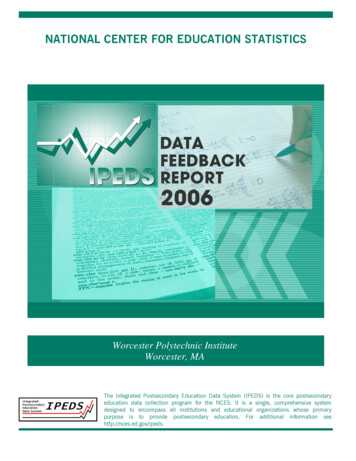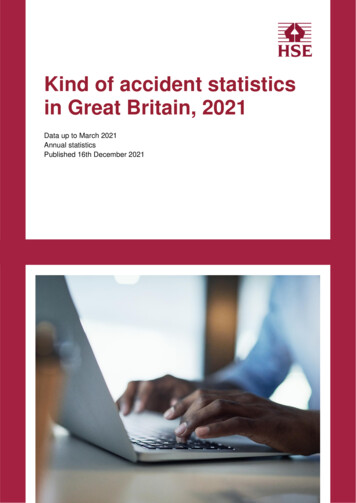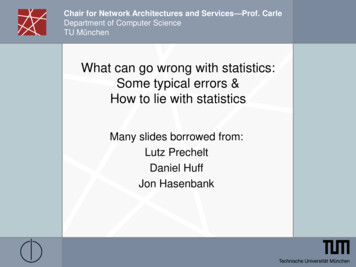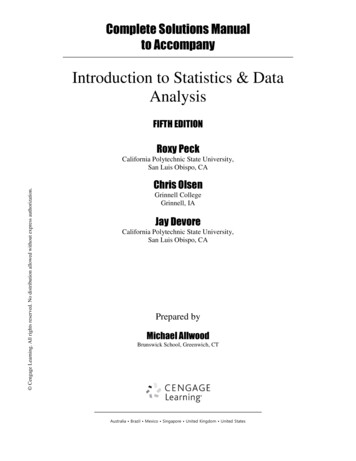
Transcription
NATIONAL CENTER FOR EDUCATION STATISTICSWorcester Polytechnic InstituteWorcester, MAThe Integrated Postsecondary Education Data System (IPEDS) is the core postsecondaryeducation data collection program for the NCES. It is a single, comprehensive systemdesigned to encompass all institutions and educational organizations whose primarypurpose is to provide postsecondary education. For additional information seehttp://nces.ed.gov/ipeds.
IPEDS DATA FEEDBACK REPORTSeptember 07, 2006Dear Institutional Executive:The National Center for Education Statistics is pleased to provide you with your institution’s annual IPEDS Data Feedback Report. Thereport compares data provided by your institution in 2005-06 through the Integrated Postsecondary Education Data System (IPEDS) to datafor a similar group of institutions. Like last year, your institution was given the opportunity to select its own comparison group. If yourinstitution did not submit its own group, IPEDS identified a comparison group for you.I also encourage you to visit the Executive Peer Tool (ExPT) at http://nces.ed.gov/ipedspas/expt/. The ExPT allows you to download a PDFof this report as well as to recreate the graphs using your comparison group or a different set of schools.Thank you for all of your efforts to support IPEDS throughout the data collection process. Without your support and the high quality data thatyou provide, these reports would not be possible. Should you have any comments on how we can improve the Data Feedback Report andthe ExPT, please send them to ipedsdatafeedback@ed.govBest regards,Elise S. MillerIPEDS Program Directoras Puerto Rico, whose primary purpose is to providepostsecondary education. IPEDS collects institution-level data onstudents (enrollment and graduation rates), student charges,program completions, faculty, staff, and finances. Each yearnearly 6,700 postsecondary institutions provide information to theU.S. Department of Education through IPEDS. These data areused at the federal and state level for policy analysis anddevelopment; at the institutional level for benchmarking and peeranalysis; and by students and parents, through the CollegeOpportunities Online Locator (IPEDS COOL athttp://collegesearch.nces.ed.gov/), to aid in the college searchprocess. For more information about IPEDS, seehttp://nces.ed.gov/ipeds.What Is The Purpose Of This Report?The IPEDS Data Feedback Report is intended to provideinstitutions a context for examining the data they submitted to theIntegrated Postsecondary Education Data System (IPEDS). Ourgoal is to produce a report that is useful to institutional executivesand that may help improve the quality and comparability of IPEDSdata.What Is In This Report?The figures provided in this report are those suggested by theIPEDS Technical Review Panel. They were developed to provideselected indicators and data elements for your institution and acomparison group of institutions. The figures are based on datacollected during the 2005–06 IPEDS collection cycle and are themost recent data available. Additional information about theseindicators is provided in the Methodological Notes at the end ofthe report. Following the figures is a list of the institutions in yourcomparison group and the criteria used for their selection. Pleaserefer to "Comparison Group" in the Methodological Notes formore information.Would You Like To Do More Analysis Of YourIPEDS Data?The information in this report can be produced for a differentcomparison group using the IPEDS Executive Peer Tool (ExPT)at http://nces.ed.gov/ipedspas/expt. If you would like to makecomparisons on a wider range of IPEDS variables, the morecomprehensive IPEDS Peer Analysis System (PAS) is availableat http://nces.ed.gov/ipedspas. In both systems, you may selectyour own comparison group by institution name or by usingselected variables. Through the ExPT, you may also printadditional copies of this report.What Is IPEDS?The Integrated Postsecondary Education Data System (IPEDS) isa system of survey components that collects data from allinstitutions in the United States and other jurisdictions, suchSELECTED FIGURESThese figures are based on 2005–06 IPEDS data submitted by your institution, Worcester Polytechnic Institute, and the comparisongroup listed later in this report. The number of institutions in the comparison group from which the median is derived is shown as "(N x)" in the labels or in the legend at the bottom of the figure.Worcester Polytechnic Institute2
IPEDS DATA FEEDBACK REPORTFigure 1. Unduplicated 12-month headcount of all students and ofundergraduate students, total FTE enrollment (academicyear 2004–05), and full- and part-time fall enrollment (Fall2005)Figure 2. Percent of all students enrolled, by race/ethnicity, andpercent women: Fall 2005NOTE: For details on calculating full-time equivalent (FTE) enrollment, see“Calculating FTE” in the Methodological Notes at the end of this report. Totalheadcount, FTE, and full- and part-time fall enrollment include both undergraduateand postbaccalaureate students, when applicable. N is the number of institutions inthe comparison group.SOURCE: U.S. Department of Education, National Center for Education Statistics,Integrated Postsecondary Education Data System (IPEDS): Spring 2006.NOTE: Median values for the comparison may not add to 100 percent. See "Use ofMedian Values for Comparison Group" for how median values are determined. N isthe number of institutions in the comparison group.SOURCE: U.S. Department of Education, National Center for Education Statistics,Integrated Postsecondary Education Data System (IPEDS): Spring 2006.Figure 3. Academic year tuition and required fees for full-time, firsttime degree/certificate-seeking undergraduates: 2003–04—2005–06Figure 4. Percent of full-time, first-time, degree/certificate-seekingundergraduate students receiving financial aid, by type ofaid: 2004–05NOTE: The tuition and required fees shown here are the lowest reported from thecategories of in-district, in-state and out-of-state. N is the number of institutions in thecomparison group.SOURCE: U.S. Department of Education, National Center for Education Statistics,Integrated Postsecondary Education Data System (IPEDS): Fall 2005.NOTE: For details on how students are counted for financial aid reporting, see“Cohort Determination for Reporting Student Financial Aid and Graduation Rates” inthe Methodological Notes at the end of this report. N is the number of institutions inthe comparison group.SOURCE: U.S. Department of Education, National Center for Education Statistics,Integrated Postsecondary Education Data System (IPEDS): Spring 2006.Worcester Polytechnic Institute3
IPEDS DATA FEEDBACK REPORTFigure 5. Types and average amounts of financial aid received byfull-time, first-time, degree/certificate-seekingundergraduates: 2004–05Figure 6. Graduation rates of full-time, first-time degree/certificateseeking undergraduates within 150% of normal time toprogram completion, by race/ethnicity: 1999 cohortNOTE: Average grant (or loan) values were calculated by dividing the total grants (orloans) awarded by the total number of recipients in each institution. N is the numberof institutions in the comparison group.SOURCE: U.S. Department of Education, National Center for Education Statistics,Integrated Postsecondary Education Data System (IPEDS): Spring 2006.NOTE: The graduation rates are the Student Right-to-Know (SRK) rates. For moreinformation see the Methodological Notes at the end of the report. N is the number ofinstitutions in the comparison group.SOURCE: U.S. Department of Education, National Center for Education Statistics,Integrated Postsecondary Education Data System (IPEDS): Spring 2006.Figure 7. Graduation rate cohort as a percent of all undergraduatesand as a percent of total entering students (Fall 2005);graduation rate and transfer-out rate (1999 cohort); andretention rates (Fall 2005)Figure 8. Number of degrees awarded, by level: Academic year2004–05NOTE: Graduation rate cohort includes all full-time, first-time degree/certificateseeking undergraduate students. Entering class includes all students coming to theinstitution for the first time. Only institutions with a mission to prepare students totransfer are required to report transfers out. Graduation and transfer-out rates arethe Student Right-to-Know rates. 4-year schools report retention rates for studentsseeking a bachelor's degree. For more information, see the Methodological Notes. Nis the number of institutions in the comparison group.SOURCE: U.S. Department of Education, National Center for Education Statistics,Integrated Postsecondary Education Data System (IPEDS): Spring 2006.NOTE: N is the number of institutions in the comparison group.SOURCE: U.S. Department of Education, National Center for Education Statistics,Integrated Postsecondary Education Data System (IPEDS): Fall 2005.Worcester Polytechnic Institute4
IPEDS DATA FEEDBACK REPORTFigure 9. Percent distribution of core revenues, by source: Fiscalyear 2005Figure 10. Core expenses per FTE enrollment, by function: Fiscalyear 2005NOTE: The comparison group median is based on those members of thecomparison group that report finance data using the same accounting standards asthe focus institution. For a detailed definition of core revenues, see theMethodological Notes. N is the number of institutions in the comparison group.SOURCE: U.S. Department of Education, National Center for Education Statistics,Integrated Postsecondary Education Data System (IPEDS): Spring 2006.NOTE: The comparison group median is based on those members of the comparisongroup that report finance data using the same accounting standards as the focusinstitution. Expenses per full-time equivalent (FTE) enrollment, particularlyinstruction, may be inflated because finance data includes all core expenses whileFTE reflects credit activity only. For details on calculating FTE enrollment and adetailed definition of core expenses, see the Methodological Notes. N is the numberof institutions in the comparison group.SOURCE: U.S. Department of Education, National Center for Education Statistics,Integrated Postsecondary Education Data System (IPEDS): Spring 2006.Figure 11. Full-time equivalent staff by assigned position: Fall 2005Figure 12. Average salaries of full-time instructional staff equated to9-month contracts, by academic rank: Academic year2005–06NOTE: Graduate assistants are not included in this figure. N is the number ofinstitutions in the comparison group.SOURCE: U.S. Department of Education, National Center for Education Statistics,Integrated Postsecondary Education Data System (IPEDS): Winter 2005–06.NOTE: Average full-time instructional staff salaries for 11/12-month contracts wereadjusted to 9-month average salaries by multiplying the 11/12-month salary by .8182.Salaries based on less than 9-month contracts are not included. Medical school staffsalaries are not included. N is the number of institutions in the comparison group.SOURCE: U.S. Department of Education, National Center for Education Statistics,Integrated Postsecondary Education Data System (IPEDS): Winter 2005–06.Worcester Polytechnic Institute5
IPEDS DATA FEEDBACK REPORTCOMPARISON GROUPUsing some of your institution's characteristics, a group of comparison institutions was selected for you. Thecharacteristics include private, not-for-profit, 4-year, degree-granting, Carnegie Classification of Doctoral/ResearchUniversities—Intensive, and enrollment of a similar size. This comparison group includes the following 25 institutions:Andrews University (Berrien Springs, MI)Antioch University-Santa Barbara Branch (Santa Barbara, CA)Ave Maria University (Naples, FL)Biola University (La Mirada, CA)Clark Atlanta University (Atlanta, GA)Clark University (Worcester, MA)Clarkson University (Potsdam, NY)Faith Evangelical Lutheran Seminary (Tacoma, WA)Florida Institute of Technology-Melbourne (Melbourne, FL)Franklin Pierce College-Graduate and Professional Studies (Rindge, NH)King's College and Seminary (Van Nuys, CA)Loma Linda University (Loma Linda, CA)Maple Springs Baptist Bible College and Seminary (Capitol Heights, MD)Midwest University (Wentzville, MO)Northland Baptist Bible College (Dunbar, WI)Polytechnic University (Brooklyn, NY)Southern California Seminary (El Cajon, CA)St Petersburg Theological Seminary (Saint Petersburg, FL)Stevens Institute of Technology (Hoboken, NJ)Union Institute & University (Cincinnati, OH)University of Bridgeport (Bridgeport, CT)University of Tulsa (Tulsa, OK)Virginia University of Lynchburg (Lynchburg, VA)Widener University-Delaware Campus (Wilmington, DE)Widener University-Main Campus (Chester, PA)Worcester Polytechnic Institute6
IPEDS DATA FEEDBACK REPORT1974, as amended; the E-Government Act of 2002; the EducationSciences Reform Act of 2002; and the USA Patriot Act of 2001.Under law, public use data collected and distributed by NCES maybe used only for statistical purposes. Any effort to determine theidentity of any reported case is prohibited by law. In order topreserve individuals’ confidentiality, data in the Graduation Ratesand Student Financial Aid components, and the Salaries and FallStaff sections of the Human Resources component of IPEDS areperturbed. Only perturbed data are available in the Peer AnalysisSystem and the ExPT; the perturbed data were used in creatingthis report.METHODOLOGICAL NOTESOverviewThe statistics and indicators in this report are based on datasupplied by institutions to IPEDS during the 2005–06 survey year.Once the data submissions were locked by the institution’skeyholder (and others), they were reviewed by the Help Desk andmigrated to the IPEDS Peer Analysis System. Response rates for2005–06 exceeded 99 percent for most surveys. Detailedresponse tables are included in the appendices to the IPEDS E.D.TABs. See http://nces.ed.gov/ipeds under "publications."Descriptions of Statistics Used in the FiguresComparison GroupsCalculating FTE EnrollmentComparison group data are included to provide a context forinterpreting your institution’s statistics. If your institution did notdefine a Custom Comparison Group for this report by June 30,2006, NCES selected a comparison group for you based on theinstitutional characteristics detailed immediately above the listingof the comparison group institutions. (If the Carnegie Classificationof Institutions of Higher Education was used as an institutionalcharacteristic in the definition of a comparison group, the 2000version was used.) The comparison group used in this report maynot reflect your institution’s peer group or you may wish tocompare your institution to multiple groups of institutions. TheExecutive Peer Tool (ExPT) (seehttp://nces.ed.gov/ipedspas/expt) can be used to produce thefigures in this report for different groups of institutions.The full-time equivalent (FTE) enrollment used in this report is thesum of the institutions’ FTE undergraduate enrollment and FTEgraduate enrollment (as calculated from or reported on the 2005Enrollment component) plus the estimated FTE of firstprofessional students. Undergraduate and graduate FTE areestimated using 12-month instructional activity (credit and/orcontact hours). First-professional FTE is estimated by calculatingthe ratio of full-time to part-time first-professional students fromthe fall counts (Part A) and applying this ratio to the 12-monthunduplicated headcount of first-professional students. Theestimated number of full-time students is added to one-third of theestimated number of part-time students. See “Calculation of FTEStudents (using instructional activity)” in the IPEDS Glossary athttp://nces.ed.gov/ipeds/glossary/.Use of Median Values for Comparison GroupCalculating FTE for StaffThe value for the focus institution is compared to the median valuefor the comparison group for each statistic included in the figure. Ifmore than one statistic is presented in a figure, the median valuesare determined separately for each indicator or statistic. Wherepercent distributions are presented, median values may not add to100 percent. Through the ExPT, users have access to all of thedata used to create the figures included in this report.The full-time equivalent (FTE) of staff is calculated by summingthe total number of full-time staff from the Employees by AssignedPosition (EAP) section of the Human Resources component andadding one-third of the total number of part-time staff.Cohort Determination for Reporting Student Financial Aidand Graduation RatesMissing StatisticsStudent cohorts for reporting Student Financial Aid andGraduation Rates data are based on the reporting type of theinstitution. For institutions that report based on an academic year(those operating on standard academic terms), student countsand cohorts are based on fall term data. Student counts andcohorts for program reporters (those that do not operate onstandard academic terms) are based on unduplicated counts ofstudents enrolled during a full 12-month period.If a statistic is not reported for your institution, the omissionindicates that one of the following conditions exists: (1) the valueof that statistic is not relevant to your institution and the data werenot collected; or (2) the data required to compute the statistic foryour institution were reported combined with data from anotherinstitution.Use of Imputed DataCore ExpensesAll IPEDS data are subject to imputation for nonresponse—bothtotal (institutional) nonresponse and partial (item) nonresponse.Imputed values are included for both your institution and anyinstitutions in your comparison group. For example, if an institutionin your comparison group did not complete the Enrollmentcomponent, NCES imputed the data for that institution AND theimputed data were used in determining the median values foreach comparison group statistic.Core expenses for public institutions (using the GovernmentalAccounting Standards Board (GASB) standards) includeexpenses for instruction, research, public service, academicsupport, student services, institutional support, operation andmaintenance of plant, depreciation, scholarships and fellowships,other expenses, and nonoperating expenses. Core expenses forprivate, not-for-profit and public institutions reporting under theFinancial Accounting Standards Board (FASB) standards includeexpenses for instruction, research, public service, academicsupport, student services, institutional support, net grant aid tostudents, and other expenses. For both FASB and GASBinstitutions, core expenses exclude expensesData Perturbation and ConfidentialityFour laws cover protection of the confidentiality of individuallyidentifiable information collected by NCES—the Privacy Act ofWorcester Polytechnic Institute7
IPEDS DATA FEEDBACK REPORTfor auxiliary enterprises (e.g., bookstores, dormitories), hospitals,and independent operations. Expenses for operation andmaintenance of plant for GASB institutions are included in othercore expenses, but are allocated to each of the other functions forFASB institutions.Core RevenuesCore revenues for public institutions reporting under GASBstandards include tuition and fees; government appropriations(federal, state, and local); government grants and contracts;private gifts, grants, and contracts; investment income; otheroperating and nonoperating sources; and other revenues andadditions. Core revenues for FASB (primarily private, not-for-profitand for-profit) institutions include tuition and fees; governmentappropriations (federal, state, and local); government grants andcontracts; private gifts, grants, and contracts; investment return;sales and services of educational activities; and other sources.Core revenues for private, for-profit institutions reporting underFASB standards include tuition and fees; governmentappropriations (federal, state, and local); government grants andcontracts; private grants and contracts; net investment income;sales and services of educational activities; and other sources. Ingeneral, core revenues exclude revenues from auxiliaryenterprises (e.g., bookstores, dormitories), hospitals, andindependent operations.Retention RatesFull-time retention rates are defined as the number of full-time,first-time, degree/certificate-seeking undergraduate students whoenter the institution for the first time in the fall and who return tothe same institution the following fall (as either full or part time),divided by the total number of full-time, first-time,degree/certificate-seeking undergraduates in the fall of firstentrance. Part-time retention rates are similarly defined. For 4year institutions offering a bachelor’s degree, this rate is reportedonly for those students seeking a bachelor’s degree. For less than4-year institutions, the rate is calculated for all degree- orcertificate-seeking students.Total Entering (undergraduate-level) StudentsTotal entering (undergraduate-level) students are all studentscoming into the institution for the first time. This includes studentswho initially attended the prior summer term and returned again inthe fall; all first-time, first-year students; students transferring intothe institution at any undergraduate level for the first time; bothfull-time and part-time students; and all degree/certificate-seekingas well as non-degree/certificate-seeking students.Tuition and Required FeesTuition is defined as the amount of money charged to students forinstructional services; required fees are those fixed sum chargesto students for items not covered by tuition that are required ofsuch a large proportion of all students that the student who doesTotal salary outlays for full-time instructional staff (by rank) onnot pay the charge is an exception. The amounts used in this11/12-month contracts were adjusted to 9/10-month outlays byreport are for full-time first-time degree/certificate-seekingmultiplying the outlay for 11/12-month contracted instructional staff undergraduates and are those used by the financial aid office toby .8182. The “equated” outlays were then added to the outlaysdetermine need. For institutions that have differential tuition ratesfor 9/10-month instructional staff to determine an average salaryfor in-district or in-state students, the lowest tuition rate is used infor each rank. Salaries for instructional staff on less than 9-monththe figure.contracts are not included.Additional Methodological InformationGraduation Rates and Transfer-out RateAdditional methodological information on the IPEDS componentsGraduation rates are those developed to satisfy the requirementscan be found in the publications available atof the Student Right-to-Know (SRK) Act and are defined as thehttp://nces.ed.gov/pubsearch/getpubcats.asp?sid 010#011.Additional definitions of variables used in this report can be foundtotal number of individuals from a given cohort of full-time, firsttime, degree/certificate-seeking undergraduates who completed a in the IPEDS online glossary available athttp://nces.ed.gov/ipeds/glossary/.degree or certificate within 150 percent of normal time (for thedegree or certificate) before the ending status date of August 31,2005, divided by the entire cohort of full-time, first-time,degree/certificate-seeking undergraduates minus any allowableexclusions. Institutions are permitted to exclude from the initialcohort students who died or were totally and permanentlydisabled; those who left school to serve in the armed forces; thoseDennis D. Berkey, Presidentwho left to serve with a foreign aid service of the federalWorcester Polytechnic Institute (ID: 168421)government, such as the Peace Corps; and those who left to100 Institute Rdserve on an official church mission. Transfer-out rate is the totalWorcester, MA 01609number of students from the cohort who are known to havetransferred out of the reporting institution within the same timeperiod, divided by the same adjusted cohort. Only institutions witha mission that includes preparing students to transfer are requiredto report transfers out.Equated Instructional Staff Salaries (Salaries Equated to 9Month Contracts)
Maple Springs Baptist Bible College and Seminary (Capitol Heights, MD) Midwest University (Wentzville, MO) Northland Baptist Bible College (Dunbar, WI) Polytechnic University (Brooklyn, NY) Southern California Seminary (El Cajon, CA) St Petersburg Theological Seminary (Saint Petersburg, FL) Stevens Institute of Technology (Hoboken, NJ)











